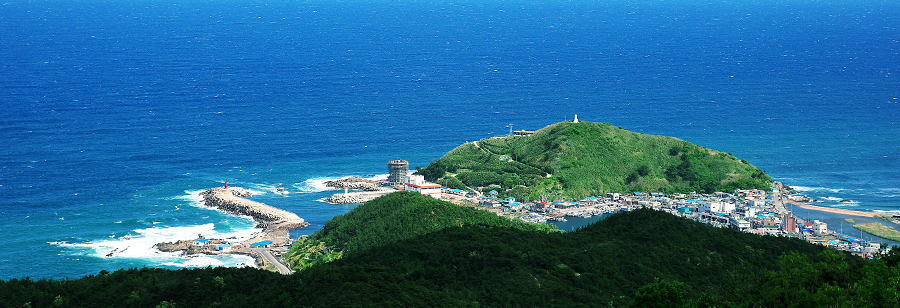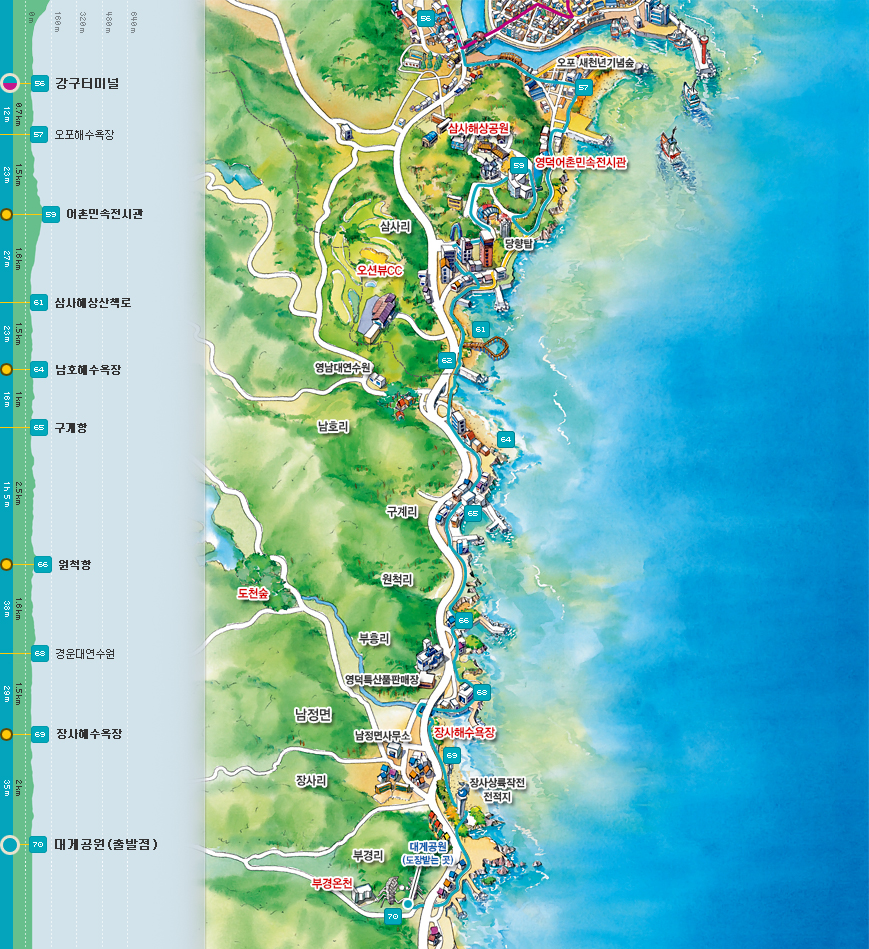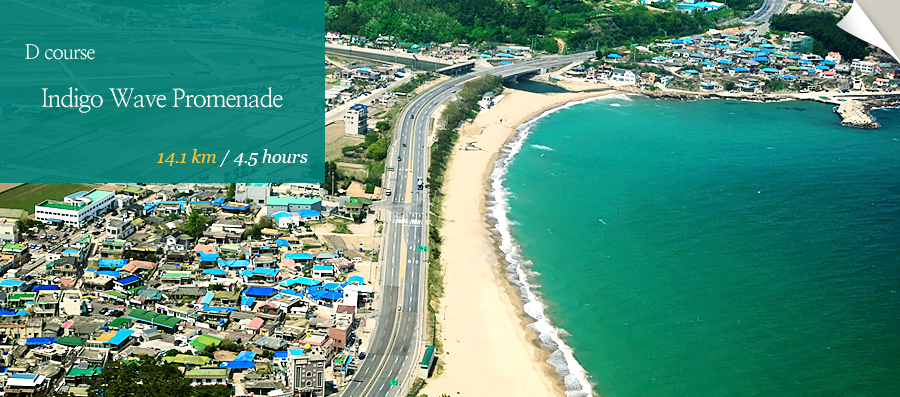

 > Overview of the BlueRoad >
D course
> Overview of the BlueRoad >
D course



I enjoy viewing the sky that I can see only here and breathing air that I can breathe only here to my heart's content because I will miss them the moment I leave this place...
Yeongdeok Blue Road on Haeparang Trail of the East Sea is the road optimized for the travel in the nature throughout the seasons, stretching 688km from Orykdo of Busan to the Reunification Observatory in Goseong-gun, Gangwon-do based on the national highway no. 7, and features the seafront path, village street, coastal road, etc., and is located at the heart of the Eastern Coast. The coastal road, village street, forest path, etc., were restored to their original state in harmony with the nature, and have been open to travellers.
Walking on the road of sequestered village and tranquil forest path with the fresh breeze blowing from the jade-colored seawater, you can get away from routine life and ask yourself questions seriously. The walking journey on Yeongdeok Blue Road will be a precious soul-searching trip to find your true ego. The 64km-long Yeongdeok Blue Road consists of 4 themes at large, namely, the Indigo Wave Promenade, Light & Wind Promenade, Blue Snow Crab Promenade, and Mokeun Promenade of Contemplation.
If you move toward the north after passing through Pohang along the national highway no. 7 that connects Busan and Onseong of Hamgyeongbuk-do, you will reach Yeongdeok, the land of bless, which has beautiful scenery formed by the exquisite view of famous mountain, such as mysterious Mt. Palgak, Mt. Chilbo, Okgye Valley, etc., which are branched off from Taebaek Mountains, blending harmoniously with the clean blue seawater of the East Sea. You can watch the sunrise wherever you go, and enjoy the sea-bathing in Yeongdeok. Endowed with tourism resources, Yeongdeok has preserved the splendid cultural heritage of ancestors intact, and is characterized by simplistic and warmhearted sentiment and beautiful legends. High quality agricultural products cultivated on fertile land and marine products are the pride of Yeongdeok.
Now! Let's set off on a journey of the Indigo Wave Promenade(Course D), the initial point on the Blue Road if you set out from the south. The Indigo Wave Promenade(Course D) is a 15km-long travel road that starts from the Snow Crab Park and is connected to Jangsa Beach, Gyeongbo Fossile Museum, Namho Beach, Samsa Marine Park, and Ganggu Terminal. The entire course is about 5-hour walk for adults.
If you arrive at Bugyeong-ri, Namjeong-myeon, Yeongdeok-gun, which is the initial point of journey on the Blue Road, you will encounter the Snow Crab Nuri formative art structure built in modern style, which welcomes the travellers to the Blue Road with generosity and kindness of the host receiving the guests.
In Namjeong Snow Crab Park, trick art of snow crab in the sea with rolling waves and photo zone gate, etc., are installed, providing the travellers with the hands-on experience of the symbolicity of Yeongdeok. The Snow Crab Nuri formative art structure, which measures 15m in height and 36m in width, towers over the Snow Crab Park, creating a scenery blending harmoniously with the silver sunlight and blue seawater of the East Sea. At night, it gives off the subtle light, revealing its splendor, and has become new landmark of Yeongdeok. If you move over the ridge of the mountain to the west from the Park, you will find Bugyeong Hot Spring that boasts of the highest quality of water.
Again, I calm myself and walk toward the north. Maybe, about half an hour has passed by. As I adapted myself to the wind and scent from the sea, I arrived at Jangsa Beach. I encountered the dense forest of pine trees that might be more than 100 years old. Overshadowed by the thick grove of pine trees, it is as dark as in the dusk. The sky viewed through the trees looks even more blue. The ray of sunlight in the forest is beaming with the treasure being broken into pieces. What jewel would be more beautiful than this? To some people, it is a cool shade against the sunlight. To others, it is a shelter to catch the breath on a long journey.
I go to the seaside for the forest-bathing to breathe in phytoncides. This beach is called, 'Jangsa Beach' because the sand field is long. Jangsa Beach measures 900m in length and 80m in width with a water depth of 1.5m on average. It keeps the white foams created by the breaking waves at the seashore. The sand particles are thick and do not have stickiness. They say that the walk on sandy beach here barefooted or sand-bathing are effective in improving cardiovascular diseases. So, I walk the sandy beach barefooted. While walking, I straighten myself up and find that the complaints in my mind, whether they are serious or trifle, seem to be drowned by the roaring sound of waves and washed away.
Jangsa Beach is the site of Jangsa landing operation which was conducted to decoy the enemy into this place and increase the chance of success for Incheon Landing Operation during the Korean War. A memorial tower was erected to remember the sacrifice of about 800 student soldiers who died heroic death, and the memorial service is held on September 14 every year. The painful scar was soothed by the nature and time. Now, even the travellers walking on this road seem to be soothed.
The County and Provincial governments plan to set aside large budget to expand the contents by 2016, such as the latest accommodation/lodging facilities, historic Jangsa landing operation victory memorial park, etc. I anticipate the Jangsa Beach which is modern, eco-friendly, and keeps the historic vestiges intact.
I am headed for the north from Jangsa Beach, and drop by the Gyeongbo Fossil Museum nestled on the seaside along the national highway no. 7 in Woncheok-ri. Gyeongbo Fossil Museum is the first and largest domestic museum of its kind. This Museum is themed around biological history and geo-history(earth history), featuring a variety of fossils classified into respective categories.
The simplistic fishing village on the coastal area attracts the travellers. Walking slowly, my mind becomes clear and tranquil maybe because the villagers are generous and warmhearted. Gugye Port adjacent to the Fossil Museum is the port famous for the most beautiful natural scenery along the national highway no. 7. Most travellers passing through this area are captivated by the picturesque scenery and stop walking unawares. Gugye Port is also one of the places where the Yeongdeok snow crabs are caught.
The ridge encircling the village smoothly and the rolling waves as flexible as downy hair give off warm impression. Gugye Port, which was a small port previously, was designated as national port. Many large or small vessels are coming into and out of this Gugye Port. The village is dotted with the sliced raw fish restaurants, and is full of life all the time.
The origin of the name 'Gugye-ri' is based on 'Habu(鰕浮)' meaning that the rock in front of the village looked like a shrimp floating in the water. It has been also suggested that Habu changed to Gubae or Gugye. In addition, some say that Gugye is the combination of Gu(turtle) and Gye(valley) because the mountain behind the village resembled a turtle and there was valley, the low land area between mountains.
The Gugye Port Breakwater attracts many fishermen throughout the seasons because the water is deep and the sea is well stocked with a variety of fish such as sea-perch, spipefish, snapper, etc. It is a good place to enjoy the trembling of the fishing rod when a fish bites the bait.
The most famous food of Yeongdeok is the snow crab. However, you can taste the snow crab easily without having to travel to the place of production. The roundnose flounder, herring, and Guamegi cannot be tasted at places other than Yeongdeok. Its name conotes that it has the prickly tergite. It has soft bone and sweet taste. People from other regions may be satisfied the most when the snow crabs are served to them. Meanwhile, people of Yeongdeok say that they are given the best reception when they are served with the roundnose flounder with prickly tergite as the best treatment. It is difficult to find the roundnose flounder with prickly tergite even in large sliced raw fish restaurants. Even if the roundnose flounder is available, its price is more than hundreds of thousands of won(Korean currency) and therefore has the scarcity value. If you set on the trip along the Course D in the morning, it is nice to have a bowl of fresh sliced raw fish in water and slake the hunger pain at Gugye Port.
If you filled up your stomach with a full bowl of sliced raw fish in water, let's set off the journey again.
The mountain encircles the sky and earth gently, and the village squats itself down under the mountain. The village on the Blue Road is secretive, quiet, and peaceful. Watching the Namho-ri quietly, you can feel how far you have gotten away from the routine life, city, and people.
Namho Beach is a small-scale beach. It has shallow water depth and gentle slope, and therefore is safe for families to enjoy the sea-bathing. Walking in the fishing village, I stop walking at the sight of flowers covering the field. Who will not be mesmerized by these pretty scenery? On the edge of the Indigo Wave Promenade, I realize how wonderful the life might be if we cherish the sea that we always have a longing for and the path(road) which we can use to set off on a journey anytime.
At a place very close to Samsa Marine Park, tourists are startled at something and walk hurriedly with curiosity. There is something in the sea. It is 'Yeongdeok Marine Promenade' that is not found on any map. You can have unique fun on the Blue Road. The bridge has the blue color same as that of the sea. The upper part of the bridge has the white color similar to the color of foams caused by the breaking waves. Transparent windows are installed on the floor of the offshore promenade, allowing the tourists to view the blue sea.
Is it exactly like walking above the seawater? It was exhilarated as if I were afloat. The marine promenade has the fan-like shape when it is viewed from the sky. I was thrilled when I entered the place resembling the handle of a folding fan and then made a round trip in the sea before exiting. Does the path to the Underwater Palace look like this? At last, I feel as if I and the sea became one.
As it is late autumn, the sunset comes earlier in the East Sea. The twilight comes as the time passes by. In Yeongdeok, the dusk gathers quietly. People can view the sunrise and sunset earlier in Yeongdeok than elsewhere. For that reason, the scenery of sunrise is quite unique and the waves are rolling in the blue sea.
Samsa Marine Park turns to the amusement park, the site of sunrise festival, when the New Year dawns. The meaning of 'Samsa(三思)' is said to be based on two stories that have been handed down. One story is that Samsa means 'Samsirang', suggesting that three persons filled the government posts in the period of Unified Silla. The other story is that Samsa means thinking three times. It means that they think while they enter, live, and leave. Tourists can lay down their wishes at this place. When I was past 80% of the ridge of the park, an uninterrupted view opened out before me. I catch my breath while enjoying the scenery. Now, I am in this wonderful scenery......My tired mind became refreshed soon. It is not very high above the ground. But I look back on my life and find that I was a person of narrow horizon.
Samsa Marine Park full of clear energy from the East Sea overlooks Namho Beach to the south and Ganggu Port to the north on the vast horizon. Particularly, Samsa Marine Park features the Manghyang Tower erected to soothe the sorrow and homesickness of migrants from the 5 Provinces of the North Korea, Grand Gyeongbuk Bell which marks the 100th anniversary of the establishment of Gyeongbuk Province, performance hall, hwamunseok(figured matting with floral patterns) woven with patterns of flowers from Jipum-myeon, Cheonjiyeon Waterfall, the simple artificial architecture, and other amenities adding the amusement to visitors. Samsa Marine Park that has the Grand Gyeongbuk Bell heralding the daybreak of the East Sea is a place to wish for good luck and renew the determination in the New Year while watching the sunrise, and has become a new tourist attraction of Gyeongsangbuk-do. In addition, it is the site for Yeongdeok Snow Crab Festival in March which is the snow crab season. This event has take root as another cultural festival.
You can explore the Fishing Village Folk Custom Exhibition Hall nestled at the endmost corner of the Park. This Exhibition Hall provides an insight into the life and folk customs of the fishing villages in Yeongdeok region. The photos showing the Yeongdeok snow crabs in old fishing net and the scenery of Ganggu Port seen through the net give us a moment of reminiscing. Along with them, various apparatus for hands-on experience are enjoyable and popular particularly among the kids. The outdoor space on the rooftop of the Exhibition Hall is another hidden tourist attraction overlooking the Ganggu Port and the East Sea from different angle.
By wrapping up the tour of the Fishing Village Folk Custom Exhibition Hall, we finalize the journey on the Indigo Wave Promenade which was newly integrated into the Blue Road.
We learn to behold even the tiny thing, listen carefully, open our mind, and reach out with sincerity. Building the rapport is not significantly different, whether it is the sea, mountain, or human. Blue Road Indigo Wave Promenade(Course D)! I enjoy viewing the sky that I can see only here and breathing air that I can breathe only here to my heart's content because I know that I will miss them soon......
If you have a chance, set out on a trip to this place. Nothing in the world would be as pleasant as being with affectionate friends of one mind and walking together along the indigo wave promenade.
Please refrain from inquiring about food and accommodation